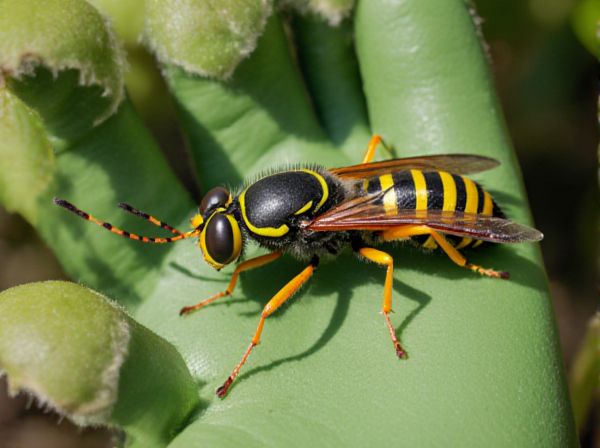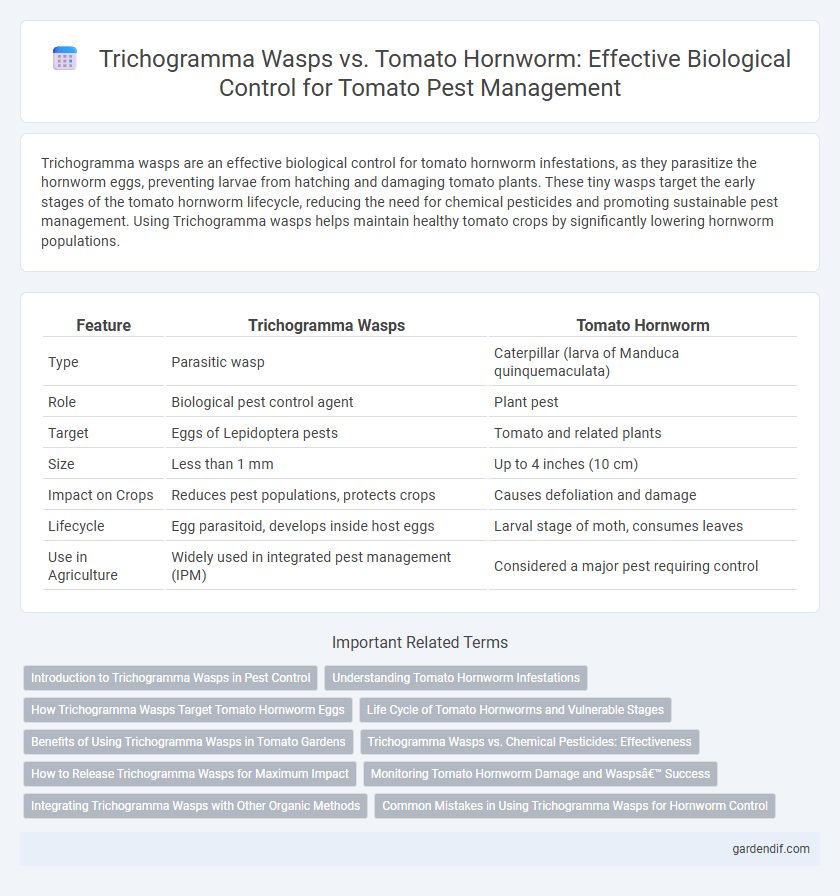
Trichogramma wasps vs Tomato hornworm Illustration
Trichogramma wasps are an effective biological control for tomato hornworm infestations, as they parasitize the hornworm eggs, preventing larvae from hatching and damaging tomato plants. These tiny wasps target the early stages of the tomato hornworm lifecycle, reducing the need for chemical pesticides and promoting sustainable pest management. Using Trichogramma wasps helps maintain healthy tomato crops by significantly lowering hornworm populations.
Table of Comparison
| Feature | Trichogramma Wasps | Tomato Hornworm |
|---|---|---|
| Type | Parasitic wasp | Caterpillar (larva of Manduca quinquemaculata) |
| Role | Biological pest control agent | Plant pest |
| Target | Eggs of Lepidoptera pests | Tomato and related plants |
| Size | Less than 1 mm | Up to 4 inches (10 cm) |
| Impact on Crops | Reduces pest populations, protects crops | Causes defoliation and damage |
| Lifecycle | Egg parasitoid, develops inside host eggs | Larval stage of moth, consumes leaves |
| Use in Agriculture | Widely used in integrated pest management (IPM) | Considered a major pest requiring control |
Introduction to Trichogramma Wasps in Pest Control
Trichogramma wasps are minute parasitic insects widely used in biological pest control to manage tomato hornworm populations in agricultural settings. These wasps lay their eggs inside the eggs of the tomato hornworm, effectively preventing the pest from maturing and causing damage to tomato crops. Their application reduces the need for chemical pesticides, promoting sustainable and eco-friendly tomato cultivation practices.
Understanding Tomato Hornworm Infestations
Tomato hornworm infestations cause significant damage to solanaceous crops by feeding on leaves, stems, and fruit, leading to reduced yields and plant vigor. Trichogramma wasps act as biological control agents by parasitizing hornworm eggs, effectively interrupting their life cycle and decreasing larval populations. Employing Trichogramma wasps in integrated pest management strategies enhances sustainable control of tomato hornworm outbreaks.
How Trichogramma Wasps Target Tomato Hornworm Eggs
Trichogramma wasps effectively target tomato hornworm eggs by parasitizing them, laying their eggs inside the hornworm eggs which result in the biological control of the pest. These microscopic wasps detect the eggs by sensing specific chemical cues, leading to the insertion of their eggs inside the hornworm eggs where their larvae consume and destroy the pest before hatching. This natural parasitism reduces tomato hornworm populations, minimizing damage to tomato crops and supporting sustainable pest management.
Life Cycle of Tomato Hornworms and Vulnerable Stages
Tomato hornworms undergo a life cycle comprising egg, larva, pupa, and adult moth stages, with the larval stage causing the most damage to tomato plants by feeding on leaves and fruit. Trichogramma wasps are effective biological control agents targeting the egg stage of the tomato hornworm, parasitizing the eggs before larvae hatch. Targeting this vulnerable egg stage disrupts the pest's development, reducing population and damage to crops without harmful chemicals.
Benefits of Using Trichogramma Wasps in Tomato Gardens
Trichogramma wasps provide an effective biological control method against tomato hornworms by parasitizing their eggs, significantly reducing hornworm populations in tomato gardens. Their use minimizes the need for chemical pesticides, promoting a healthier ecosystem and safer produce. Integrating Trichogramma wasps supports sustainable pest management by enhancing natural pest suppression and preventing damage to tomato crops.
Trichogramma Wasps vs. Chemical Pesticides: Effectiveness
Trichogramma wasps provide a targeted biological control against Tomato hornworm by parasitizing their eggs, significantly reducing larval populations without harming beneficial insects or the environment. Chemical pesticides often offer immediate and broad-spectrum pest suppression but can lead to resistance, non-selective toxicity, and environmental contamination. Studies demonstrate that integrating Trichogramma wasps into pest management programs enhances long-term control efficacy while minimizing ecological risks compared to relying solely on chemical pesticides.
How to Release Trichogramma Wasps for Maximum Impact
For maximum impact against tomato hornworms, release Trichogramma wasps during early evening when temperatures range between 20-30degC, as they are most active in moderate warmth. Distribute wasps evenly across infested tomato plants, focusing on egg-laying sites of hornworms to ensure effective parasitism. Maintain high release frequency, approximately weekly, to sustain populations and achieve consistent biological control throughout the growing season.
Monitoring Tomato Hornworm Damage and Wasps’ Success
Trichogramma wasps play a critical role in monitoring tomato hornworm damage by parasitizing the hornworm eggs, significantly reducing larval populations before they cause extensive foliage loss. Regular field inspection for white or black parasitized eggs indicates the success rate of wasp activity and provides an early warning system for potential hornworm outbreaks. Effective use of Trichogramma wasps as a biological control agent minimizes the need for chemical pesticides, promoting sustainable tomato crop health.
Integrating Trichogramma Wasps with Other Organic Methods
Integrating Trichogramma wasps with organic methods such as neem oil applications and row covers enhances control of tomato hornworm by targeting multiple life stages and reducing egg viability. Trichogramma wasps parasitize hornworm eggs, while neem oil disrupts larval development and row covers physically block moth oviposition. This combination increases pest suppression, minimizes chemical pesticide use, and promotes sustainable tomato crop health.
Common Mistakes in Using Trichogramma Wasps for Hornworm Control
Common mistakes in using Trichogramma wasps for tomato hornworm control include releasing them at the wrong time of the hornworm's life cycle, which reduces parasitism effectiveness. Improper environmental conditions such as high temperatures or pesticide exposure can significantly decrease wasp survival and activity. Additionally, failing to provide adequate habitat or alternative hosts can limit Trichogramma wasp establishment and long-term pest suppression.
Trichogramma wasps vs Tomato hornworm Infographic

 gardendif.com
gardendif.com